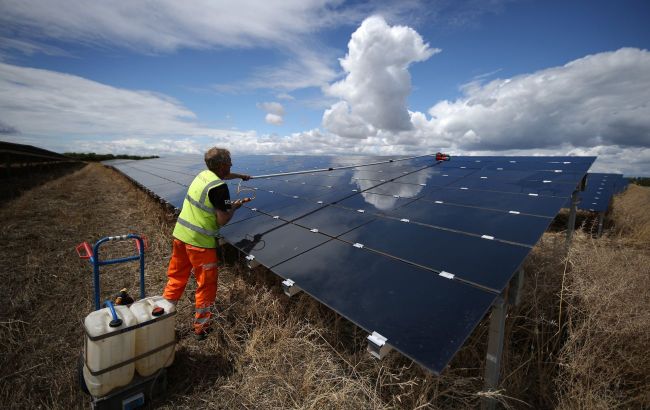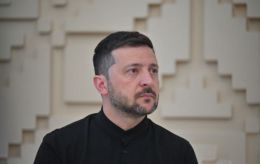Green energy: Pros, cons, and why Ukraine needs energy transition
 Photo: Solar energy is to play an important role in Ukraine's green transition (Getty Images)
Photo: Solar energy is to play an important role in Ukraine's green transition (Getty Images)
Last week, Ukraine approved the energy and climate plan until 2030. Among other things, it provides for increasing the share of so-called green energy in generation and consumption.
RBC-Ukraine dwells on green energy, its advantages, and disadvantages, as well as what the green transition is.
Contents
The Cabinet of Ministers approved the National Energy and Climate Plan (NECP) until 2030. This is a strategic document aimed at harmonizing environmental, energy, and economic policies regarding the sustainable development of Ukraine.
The plan was developed following the requirements of the European Union Regulation 2018/1999 and taking into account the best practices of EU member states, within the framework of Ukraine's commitment as a contracting party to the Energy Community and in the process of joining the EU.
The NECP was adopted on June 25, the same day when negotiations on joining the European Union were officially launched. And this is symbolic since the new energy strategy is an important part of European integration.
"The national plan was prepared in a record short time - less than a year. The total investment needs are 41.5 billion dollars. Its implementation will not only contribute to the decarbonization of our country's economy but will also open up significant opportunities for attracting resources to implement the plan," noted First Vice Prime Minister, Minister of Economy Yulia Svyrydenko.
Among the main goals of the plan:
- reduction of greenhouse gas emissions by 65% compared to the level of 1990
- achieving a 27% share of renewable energy sources in the total final energy consumption
- diversification of sources and supply of energy resources - no more than 30% from one supplier.
As the director of the Secretariat of the Energy Community Artur Lorkowski stated, the document will become a plan for the green reconstruction and recovery of Ukraine, stimulating assistance from the international community.
According to him, attention should now be focused on the implementation of measures following the requirements of the Ukraine Facility (a support program from the EU for 50 billion euros) and the Energy Community legislation.
He adds that continuing Russia's brutal attacks on civilian and energy infrastructure make it necessary to constantly monitor the implementation of the plan and continue high-level discussions on how Ukraine can adapt to changing circumstances.
Green energy: Advantages and disadvantages
When talking about renewable energy sources, the terms 'clean' and 'green' energy are usually used. Often they are interchangeable, although they still have differences in meaning.
Renewable energy focuses on sources that regenerate naturally over a short period, such as sunlight, wind, or flowing water. Clean energy emphasizes the absence of emissions, and green - the absence of a negative impact on the environment. Green energy encompasses renewable sources with minimal or no greenhouse gas emissions.
Nuclear energy is considered clean, but not renewable, since its source - uranium - is a fossil fuel. Hydropower uses water as a renewable resource, but large dams generate methane emissions through the decomposition of plant material in the reservoirs. Therefore, nuclear and hydropower do not meet the more stringent requirements to be considered green energy.
There are six main types of renewable energy: solar, wind, geothermal, tidal energy, hydro- and bio-energy.
One of the main sources of renewable energy is the sun. Such energy is generated by converting sunlight into electricity using special panels. In Ukraine, according to the NKRECP register, there are up to 1,400 solar power plants. At the same time, the number of households is estimated at more than 50 thousand.
In wind energy, special turbines capture the kinetic energy of the wind and convert it into electricity. Such stations are located in areas with high wind speeds. Today, about 70% of the capacities are located in the temporarily occupied territories of Kherson, Zaporizhzhia, Donetsk, and Luhansk regions. The main stations in the controlled territories are in the Mykolaiv, Odesa, and western regions of Ukraine.
In hydropower, dams and other infrastructure are used to convert the energy of flowing or falling water into electricity. The main stations are located on the cascades of two large rivers - Dnipro and Dniester. The Russians destroyed the Kakhovka HPP in June 2023, and this year they seriously damaged the Dnipro HPP with missile strikes.
Advantages
Reduction of emissions. In contrast thermal solar, wind, and hydroelectric power plants almost do not lead to greenhouse gas emissions. Which helps fight global warming.
Energy independence. Renewable energy sources are widespread, and their use allows reducing dependence on fossil fuel imports.
Jobs and economic growth. Investments in solar and wind farms create jobs in manufacturing, installation, maintenance, research, and development. The decentralized nature of renewable energy projects stimulates local economies and can revitalize rural communities.
Price stability. Advances in technology have led to a reduction in the cost of renewable energy production. For example, solar and wind power are becoming increasingly competitive in many regions. And free natural resources are not subject to market fluctuations and geopolitical factors.
Health and ecology. Alternative energy leads to minimal air and water pollution. Therefore, the green transition will improve air quality, reduce the incidence of respiratory diseases, and increase indicators of health care and quality of life.
Sustainability of resources. Renewable energy sources rely on inexhaustible resources (sun, wind, and water). Unlike the finite amount of fossil fuels, they can be used indefinitely.
Disadvantages
High capital costs. Solar panels and wind turbines require significant initial investment, which can be prohibitively expensive for individuals and companies.
Unreliable production. The use of solar, wind, and water energy makes electricity production unpredictable and dependent on weather conditions. Hence the problems with interruptions. Solar panels need light, wind turbines need wind, and hydroelectric plants need sufficient water. These factors can affect the stability of generation.
Geographical restrictions. Solar panels are more efficient in sunny regions, and wind farms are more efficient in areas with constant wind. This limits the widespread use of some renewable energy sources.
Storage options. Energy storage technologies are needed to compensate for the intermittent nature of generation. However modern batteries, due to their high cost, are not yet a viable system for supporting renewable sources.
Space requirements. Solar panels and wind farms require significant space for production facilities. Which is a problem in densely populated areas or areas with limited land availability.
Green transition. Why is it for Ukraine?
The current transition to renewable energy sources and other types of sustainable energy is driven by the view that carbon emissions must be reduced to zero.
Since fossil fuels are the largest source of emissions, many countries agreed to limit production in the 2015 COP21 Paris Agreement to keep global warming below 1.5 degrees.
In recent years, the term 'green transition' has been used to denote the transition to sustainable energy due to the wider integration of renewable sources into the sphere of everyday life (transition to the so-called 'green economy').
The leadership in the field of green transition is demonstrated by the European Union. According to the European Green Deal strategy adopted in 2020, Europe should become the first climate-neutral continent by 2050. That is, to completely stop emissions that would contribute to global warming.
Intermediate goals until 2030 have also been defined:
- accelerated phase-out of internal combustion engine vehicles
- 40% share of renewable energy (in 2021 it is 20%, although the indicators differ in different countries)
- planting 3 billion new trees
- introduction of a tax on aviation fuel and a special carbon tax on imported products of environmentally harmful industries
In January, Belgium produced more electricity from renewable sources than from fossil fuels for the first time. But it went to it gradually. If in 2019 the share of wind and solar energy was 13.4%, then in 2022 - 19.5%. And not only more wind and solar stations were built. Electricity production at nuclear power plants was reduced in the country. A similar trend can be observed in Germany. And in Sweden, as early as 2021, renewable sources have reached 60% in the generation structure.
Synchronization with the European course means not only bringing energy standards necessary for Ukraine's accession to the European Union. Green transition is the only way to achieve energy security.
Moreover, Russia's full-scale war does not stop, but, on the contrary, accelerates the green transition of Ukraine.
"Not only does the war not stop our desire to make a green transition, but on the contrary, it accelerates this process. Ukraine has all the necessary prerequisites and aims to become the energy hub of Europe, helping partners to finally get rid of dependence on Russian hydrocarbons and achieve the goals of climate neutrality," says Ukrainian Energy Minister Herman Halushchenko last December, emphasizing Ukraine's high potential for the development of wind and solar generation, as well as hydrogen technologies.

